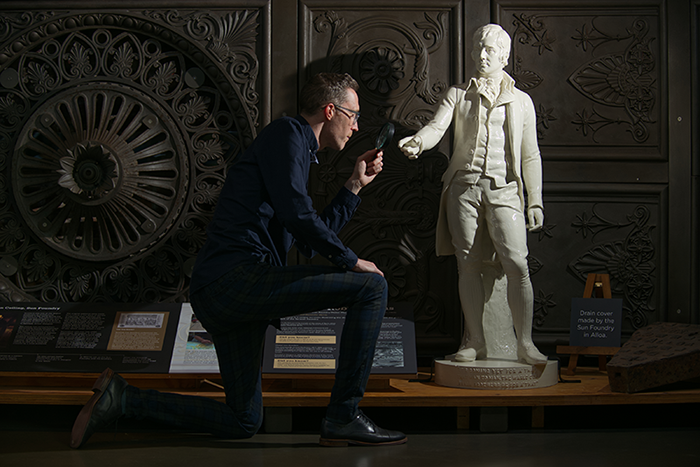
A rare cast-iron statue of Robert Burns, discovered in a compost heap in the 1950s in Durban, South Africa, has made its new home at the Engine Shed, Scotland’s dedicated building conservation centre in Stirling.
The statue had been in Cape Town but was lost and forgotten until it was rediscovered under a compost heap in a garden in Durban. The statue remained in South Africa until purchased by Paul and Alexandra Morris in 2013, who organised for it to be shipped back to Scotland.
The statue was designed by sculptor David Watson Stevenson and originally cast at McFarlane’s Foundry in Saracen, Glasgow, prior to the First World War. The Saracen Foundry had a reputation for producing high quality pieces of work, many of which are now considered to be of historical importance.
After its rediscovery, the statue was transported back to the Morris’s home in Alloway. There, ‘Rusty Rabbie’ was restored, including lead testing on flakes of paint to confirm the original colour. It has now been re-painted with colours that reflect the original finish from when it left the McFarlane’s Foundry around 1900.
After enjoying sharing their home with Rabbie and giving talks about his discovery at Burns Clubs and historical societies, Paul and Alexandra Morris decided the time was right for him to move to a place where he would be fully appreciated and used for educational purposes, kindly donating him to HES.
The statue will be on display at the Engine Shed as part of the site’s Doors Open Days weekend, where visitors will be able to learn about the iron founders competing to make the best metalwork – from statues like Rabbie to massive decorative cast iron ceilings – and the traditional metalworking techniques they used.
Rachael Dorman, technical education and training programme delivery manager at HES, said, “We are excited to open our doors on 21 and 22 September to give visitors a behind-the-scenes look at how Scotland is at the forefront of conservation and heritage research. From traditional skills and materials to digital and scientific innovation, there is a wealth of information and insights for visitors to enjoy at the Engine Shed.
“We’re particularly pleased to unveil the cast-iron statue of Robert Burns, which is fascinating both for its confounding history and as likely the only surviving example of its kind. We’re grateful to Paul and Alexandra for their generous donation, and the way in which this statue was made can teach us much. We hope this intriguing representation of our national poet will inspire visitors to learn more about the history and legacy of ironwork in Scotland.”
On Saturday 21 and Sunday 22 September, the Engine Shed will be running two sessions each day as part of Doors Open Days. Entry is free, however booking is essential as spaces for each session are limited. For more information and to book, please visit www.engineshed.scot











